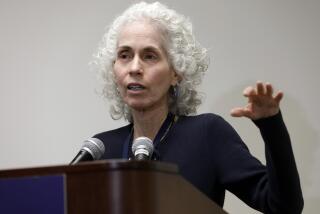Reports Predict Dire Health Scenario for L.A. County’s Poor : Medicine: The studies indicate that indigents would face possible life-threatening care shortages if Lancaster hospital is closed.
- Share via
As county officials grapple with how to provide adequate health care in the face of a mammoth budget gap, two reports indicate that private hospitals and physicians cannot be counted on to care for the poor.
One study, conducted in June by the Los Angeles County Department of Health Services, predicted that the closure of High Desert Hospital in Lancaster would create possible life-threatening health care shortages in the remote area.
A second health department report concluded that proposed closures and cutbacks would mean increased waiting times at surviving county hospitals and clinics--including six-month waits at Olive View-UCLA Medical Center in Sylmar, where most of High Desert’s patients would be sent.
Health department officials believe that scenario would be repeated throughout the county if one or more of its six public hospitals close.
“In every area, there will be not enough access, not enough people to care for the indigent,” said Walter Gray, the health department’s assistant director.
As part of an effort to reduce a $655-million deficit in the county health department, High Desert and three other public hospitals are on one proposed closure list, while County-USC Medical Center is on another.
Closing High Desert would save the cash-strapped county $35 million, and eliminate 629 jobs.
Although county Chief Administrative Officer Sally Reed favors closing County-USC, a specially appointed health task force is assessing the situation.
As part of its evaluation, the task force is looking at the health department’s High Desert report, which explored whether the area’s three private hospitals might pick up the slack if High Desert closed. The three are operating at only about 50% of capacity, a rate typical of many private hospitals in the county.
But all three--Antelope Valley Hospital Medical Center, Lancaster Community Hospital and Desert Palms Community Hospital--said they would not care for the county hospital’s poorest patients, except in emergencies, as required by law.
Only Antelope Valley Hospital agreed to accept new Medi-Cal patients--those low-income people covered by the state’s public medical insurance. Antelope Valley Hospital is the only one of the three that has a contract with the state to provide Medi-Cal services.
An added problem, the 60-page report noted, is that none of the private hospitals has adequate staffing, space and equipment to offer the level of outpatient services now provided at High Desert.
The response of local physicians was no better, according to the study, as only six of the 22 interviewed agreed to see new Medi-Cal patients, and none were willing to accept new patients without insurance.
As a result, the report said, High Desert’s 39,786 annual Medi-Cal patients, and the 29,864 more without any insurance, would have little or no access to adequate local health care.
While most patients with insurance “could likely be absorbed by the private hospitals in the area,” the report states, “indigent inpatients, most outpatient specialty services, and uncompensated rehabilitation and skilled nursing services would have to be referred to other county facilities . . . out of the area.”
Most people, according to the report, would be referred to the local county health clinic--Antelope Valley Health Center--or to Olive View, as much as an hour’s drive away.
Even those who made it to Olive View would face interminable waits because of cutbacks there, according to the second study, which projected the impact of hospital closures on a countywide basis.
The Sylmar hospital faces the cutback or elimination of 23 outpatient services it offers, producing 20,000 patient visits annually, including general surgery.
The private hospitals and doctors say they would be unable to take on most of the patients for fear of risking their financial stability.
Private hospital administrators noted that they lose money when they care for uninsured patients and often do not receive adequate compensation from the state when they treat Medi-Cal patients.
Meanwhile, county health officials say they cannot guarantee private hospitals a certain number of Medi-Cal patients--to help offset the loss on the uninsured patients--because state law grants Medi-Cal patients the right to choose their hospital.
In fact, county hospitals are reluctant to give up Medi-Cal patients even in the event of closures because they form the fiscal backbone of the public health care system. That helped unravel negotiations between the county and a consortium of private hospitals, which recently offered to pick up some Medi-Cal patients.
“That’s what they butted heads over, but I think they can work something out,” said Jim Lott, a vice president with the Healthcare Assn. of Southern California, which represents 230 public and private hospitals.
Desert Palms Hospital, a private, 123-bed facility in Palmdale, provides a good example of the predicament facing private hospitals. Currently, 35% of its patients are indigent (without any health insurance whatsoever, with many of them believed to be illegal immigrants), and another 35% are on Medi-Cal, the state insurance system for low-income, legal residents.
Desert Palms Administrator Elizabeth Scarcelli fears that if High Desert were to close, the number of poor patients at her hospital would increase, particularly in her six-bed emergency room, which had 18,000 visits last year. “As a hospital, you have to expect a certain part of the service you provide to be pro bono if you are at all moral and ethical,” she said.
More to Read
Sign up for Essential California
The most important California stories and recommendations in your inbox every morning.
You may occasionally receive promotional content from the Los Angeles Times.









